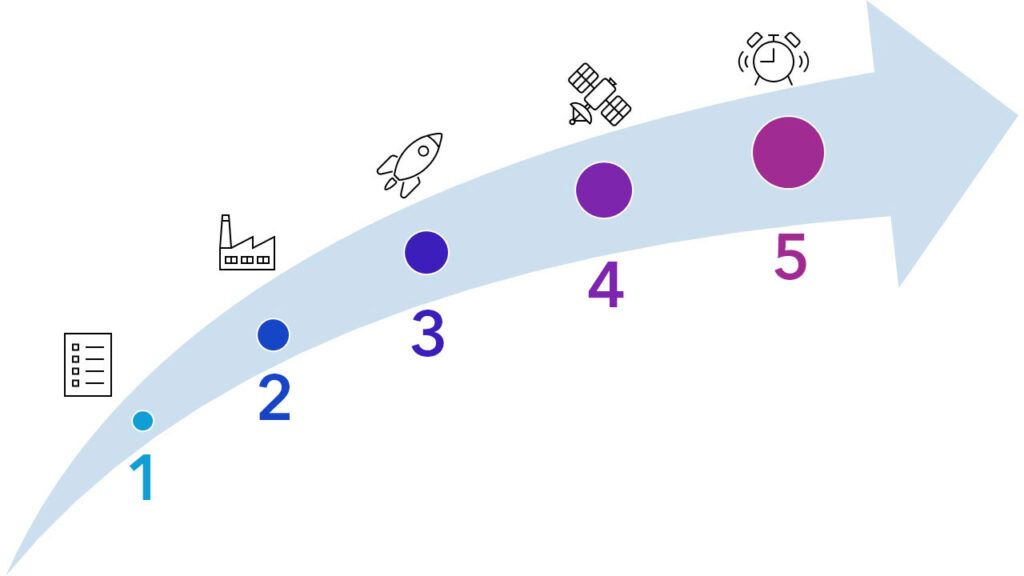
Critical registrations along the satellite lifecycle
By Veronique Glaude, Senior Radiocommunication Engineer, ITU; Andrew Marchetti, External Relations Officer, UNOOSA; and Scarlet O’Donnell, Director, International Institute of Space Law (IISL)
Launching a satellite is a high-stakes endeavour, putting technical ambition up against the harsh realities of outer space.
Yet beyond the engineering challenges, two pivotal regulatory processes underpin every successful satellite mission: securing radio-frequency spectrum through the International Telecommunication Union (ITU) and submitting registration information on objects launched into outer space to the United Nations Office for Outer Space Affairs (UNOOSA).
Far from being mere bureaucratic hurdles, these actions are a prerequisite for transparency, coordination and the sustainable use of orbital resources. They also determine liability and facilitate identification should the worst happen, particularly when a space object re-entry occurs.
Today, as low Earth orbits get increasingly crowded, these steps remain a pillar of international space coordination.
Regulators, space agencies, diplomatic missions and other specialized institutions need to be familiar with the process. A recent workshop for space experts and diplomats looked at the satellite lifecycle, starting with pre-launch filings to ITU and outlining the pathways for submitting registration information to UNOOSA.
ITU filings secure the invisible lifeline
Before a satellite ever reaches orbit, its operator must navigate the complex landscape of radio-frequency spectrum management through its respective national administration.
ITU oversees this critical phase, where engineers and national regulators collaborate to file for and assign radio frequencies for use from any expected orbital location.
The recording process, governed by the Radio Regulations treaty, requires compliance with its Table of Frequency Allocations.
Satellite spectrum filings are only entered into the Master International Frequency Register (or Master Register) after undergoing rigorous coordination to avoid harmful radio interference between different services and ensure equitable access to limited spectrum and orbital resources.
UNOOSA tracks the celestial inventory
Once launched, every space object should be recorded in the UN Register of Objects Launched into Outer Space, which is maintained by UNOOSA on behalf of the United Nations Secretary-General, António Guterres.
Registration of space objects is a cornerstone of international space law, rooted in the Outer Space Treaty (1967), Registration Convention (1975) and UN General Assembly Resolution 1721 (XVI): “International co-operation in the peaceful uses of outer space” (1961).
The United Nations offers two vehicles for submission of registration information, depending on whether states have ratified the Registration Convention. State parties to the Registration Convention must first register their space objects in a national registry and then officially notify the UN as soon as practicable after launch.
In addition, non-state parties can furnish information on their space objects for the UN Register voluntarily.
The Committee on the Peaceful Uses of Outer Space (COPUOS) has developed global governance since the start of the space age. Today, COPUOS remains – through five outer space treaties and the UN Guidelines for the Long-Term Sustainability of Outer Space Affairs – the primary international forum for discussing, refining and harmonizing space registration practices.
See LTS Guideline A.5 on registration.
Five life stages

In fact, ITU and UNOOSA registrations continue across the whole satellite lifecycle:
- Project: Any new satellite project needs to identify ITU filing characteristics and in which country to request national registration of the satellite(s).
- Manufacture: Once plans are set and the object is being assembled, ITU filing is required to enable subsequent coordination needs.
- Launch: Before joining orbit, each satellite must conform with its filing in ITU’s Master Register. The object must (State Parties to the Registration Convention) or can (non-State Parties) be entered into a national registry of space objects, with the same information also being submitted to UNOOSA fulfilling its role of maintaining the UN Register.
- Operation: Typically circling the planet for years or decades, satellites must operate within parameters for spectrum protection based on the ITU Master Register, as well as conform with international law and be maintained in the national registry and UN Register.
- End of life or orbital change: When a satellite’s mission ends or changes, its corresponding filing must be updated or suppressed in the ITU Master Register (unless a replacement satellite immediately takes its place). National registries and the UN Register must also be updated accordingly.
Why space registrations matter in shaping future exploration
ITU satellite spectrum filings and UNOOSA registration submissions provide a stable environment enabling innovative space applications and new entrants to orbital space.
The private sector – now a major actor in space – demands robust, adapted regulatory frameworks to manage risks, prevent disruptions and uphold the principles of peaceful, sustainable and interference-free space exploration.
The two-day workshop with ITU and UNOOSA aimed to demystify the filing and registration processes.
Experts from the two organizations led sessions on the evolving regulatory landscape, exchanging practical insights on spectrum coordination, national registration, pathways for notifying the UN and the legal foundations that underpin the global space community.
Smooth satellite operations depend increasingly on cooperation among national administrations, commercial entities and international organizations.
This makes effective regulation as crucial to mission success as rocket science itself.
“Space is fundamentally about collaboration,” noted Corinne Kitsell, UK Ambassador to international organizations based in Vienna, Austria. “We will only achieve our goals by working together.”
The joint online workshop, “From an ITU filing to registration with UNOOSA – The lifecycle of a satellite,” took place on 4 and 5 June 2025, with regulators, space agencies, diplomats and experts from around the world enhancing their knowledge and sharing insights.
An UNOOSA project – “The Registration Project: Supporting Implementation of Treaty Obligations related to the Registration of Objects Launched into Outer Space,” and an associated workshop – was made possible through the generous support of the Government of the United Kingdom.
UNOOSA will launch a “good practice toolkit” of national and international registration practices at its Space Law Conference: Operationalising Space Sustainability, in Vienna on 19-20 November 2025.
International cooperation and satellite coordination were also key topics for ITU’s Space Sustainability Forum in Geneva, Switzerland, 7-8 October 2025.
Header image credit: Adobe Stock
